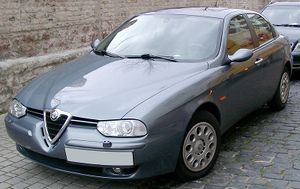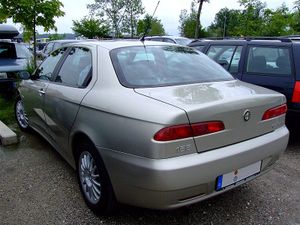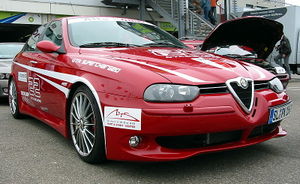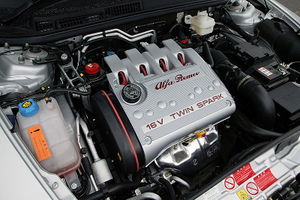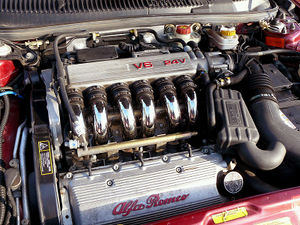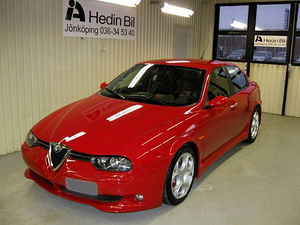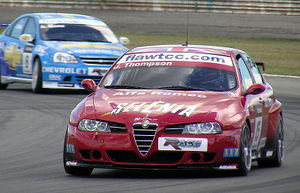Alfa Romeo 159

| |
| Alfa Romeo 159 | |
|---|---|
| Manufacturer: | Alfa Romeo |
| Production: | 2005-present |
| Layout & Class: | FF Mid-size car |
| Body styles: | 4-door sedan or Stationwagon |
| Engines: | 140 bhp 1.8-litre 160 bhp 1.9 JTS 185 bhp 2.2 JTS 230 bhp 2.8 JTS V6 260 bhp 3.2 JTS V6 120 bhp 1.9 JTD 150 bhp 1.9 JTD 200 bhp 2.4 JTD 250 bhp 3.0 JTD V6 |
| Related: | Alfa Romeo Brera Alfa Romeo Spyder Alfa Romeo Kamal |
| Predecessor: | Alfa Romeo 156 |
| Successor: | Still in production |
| Competitors: | Acura TSX Audi A4 BMW 3-Series Jaguar X-Type Lexus IS 300 Mercedes-Benz C-Class |
| Designer: | Giorgetto Giugiaro |
The Alfa Romeo 156 (known internally as the type 932) is a compact executive car introduced by Italian automaker Alfa Romeo at the 1997 Frankfurt Motor Show as the replacement for the Alfa Romeo 155. Cars were assembled at Fiat Group factory in Pomigliano d'Arco, Italy and General Motors facility in Rayong[1], Thailand (production in Thailand started March 2002 and lasted couple of years, cars were targeted for Asia Pacific markets). Between 1997 and 2005, 680,000 examples of the 156 were produced, a huge success for the brand.
The 156 was available in saloon and estate 'Sportwagon' bodystyles with seven engine configurations and it went through two facelifts, first in 2002 and second in 2003.
The 156 saloon was discontinued late in 2005 in Europe, the four-wheel drive Q4 Crosswagon was produced to the end of 2007. The 156 was replaced with 159, which also spawned the Brera, the two door coupe that replaces the Alfa Romeo GTV along with its convertible sister the new Spider.
Development
At the beginning the engine range encompassed four cylinder Twin Spark (1.6 L 120 PS, 1.8 L 144 PS and 2.0 L 155 PS) 16 valve engines with variable valve timing, along with the straight-4 1.9 litre 8-valve 105 PS and straight-5 2.4 litre 10-valve 136 PS JTD common rail turbodiesel engines. Until January 2002, the range-topping engine was the venerable double overhead camshaft 2.5 litre 24-valve Alfa Romeo V6 engine rated at 190 PS.
Initially the 156 range was available with different options (packs) like a sport pack that could include either Blitz clothing , Momo leather interior or Recaro seats, it also included 16 in wheels, lowered suspension and leather steering wheel and gear knob. There was also available De-Luxe pack with Momo's mahogany steering wheel and gear knob and for Nordic countries special winter pack consisting of fog lights, headlight washers and heated seats.
Starting from 1999 five-speed Selespeed sequential transmission came as an option to 2.0 litre Twin Spark version and four-speed automatic Q-System to 2.5 litre V6 version, the Q-system can be used as normal automatic or shift manually with H-pattern, it has three automatic modes: city, sport and ice.
A significant addition to the 156 range was the Sportwagon estate in 2000, a first attempt at an estate car of this size for the company. Sportwagon was also available with Boge-Nivomat self-levelling hydropneumatic rear suspension. The Sportwagon was marketed as lifestyle estate without large carrying capacity.
The Sportwagon bodystyle filled a gap in the market that Alfa Romeo had distanced themselves from since the 33 SportWagon of the 1980s.
In 2001 engines were upgraded, engines complied with Euro3 norm and outputed 120 PS (1.6 L), 140 PS (1.8 L), 150 PS (2.0 L) and 192 PS (2.5 L).
Exterior styling
The 156 was designed by Alfa Centro Stile under control of head designer Walter de'Silva. Its distinctive style with its high curved flanks, retro styled front door handles, hidden rear door handles, dramatic deep grille and sweeping profile made it, to some, the best looking car in its class. The car was one of the first saloons to feature hidden rear door handles and prominent front door handles to give it a coupé look. The design was influenced by three historical Alfa Romeo models: the 1900, the Giulietta and the Giulia. The 156 achieved a drag coefficient (Cd) of 0.31.
Interior styling
The 1998 original interior builds on a benchmark set by Alfa Romeo in their previously released Alfa Romeo 166, with a deeply scalloped upper dashboard and simple centre console. All of the main controls and displays are angled towards the driver in typical Italian sports car style, although this can sometimes be awkward for passengers who will struggle to see the interior clock. Despite being a family car, the interior design lacks cup holders, which normally come standard in saloons. Typically, for a smaller executive car, there is ample room up front for the driver and passenger to sit comfortably, with very comfortable seats. However, rear seat passengers may find the design restrictive in overall room. The 156 is a car for four people, rather than five, although later models did add a full centre seatbelt in place of the lap belt in earlier models.
2002 saw an update to both the interior and exterior of the 156.
Platform and suspension
The 156 uses a new platform denominated Tipo 3 third series Platform. The 156 is a highly-developed front-wheel drive car; (the Cross/Sportwagon Q4 offered four-wheel drive in left-hand drive markets) with a double high wishbone front suspension and all independent multi-link rear suspension, which consists of a telescopic vertical strut with coaxial spring and two transverse links of different lengths and a longitudinal strut. This structure means that the rear wheels have a small passive steering ability. Weight saving material (aluminum) has been used in several parts both front and rear suspension. The weight saving materials were also used in many other parts like magnesium framed front seats.
Facelifts
2002 facelift
2002 also saw the arrival of a facelifted interior with different matte-finish surfacing and chrome highlights. New version used the 147's dual-zone digital climate control and CanBus serial wiring system, the interior climate could also be controlled via air quality sensor. A different choice of colours were available for the interior, with the option of a two-tone interior very much like that BMW were introducing at the time. A wider range of options including xenon lighting, tele-informatics (CONNECT and CONNECT NAV) and a Bose stereo system were available, the stereo system could now also be operated via buttons on the steering wheel. Also the Selespeed gearbox control system was updated, buttons at steering wheel were replaced by paddle shifters, like seen earlier on Alfa Romeo 147. In the center console was added multifunctional display with trip computer, fault and service monitor. Also electronic stability control VDC (Vehicle Dynamic Control) and slip control ASR (Anti Slip Regulation) came as standard. Passive safety was also made better, all versions got window airbags as standard. The 2.0 L JTS 165 PS gasoline direct injection engine replaced the 2.0 litre Twin Spark engine, offering more low end torque and more power than the Twin Spark, diesel engines were also uprated. Only notable difference exterior-wise was body coloured mirrors and bumper strips which were earlier black.
2003 facelift (2nd series)
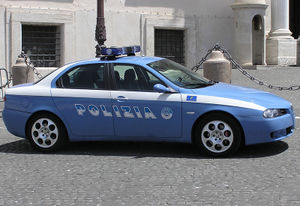
Late 2003 saw the launch of a facelifted 156, with new front and rear fascias designed by Giorgetto Giugiaro. To the top of range was added new TI trim level (Turismo Internazionale) designating a sporty kit, this version was equipped with modified suspension, bigger wheels (215/45 17") and leather-trimmed interior. This mid-life facelift divided opinion with some preferring the prettier pre-facelift look with others singing the praises of the newer more aggressive demeanour of the latter models. The GTA models never received the exterior update. Diesel engines underwent a major re-working, new four valve per cylinder heads were added, second stage common rail injection with 1400 bar maximum injection pressure with up to five injections per cycle for lower noise, consumption and higher performance. They were rated at 140/150 PS (103/110 kW) for straight-4 1.9 litre 16-valve and 175 PS for straight-5 2.4 litre 20-valve.
2004 Q4 variants
In 2004, Q4 (short for Quadrifoglio 4) four-wheel drive versions arrived to some markets, which were known as the Crosswagon Q4 and Sportwagon Q4 (both using the 1.9 L 150 PS JTD diesel engine). These cars were equipped with a Torsen C four-wheel drive system and raised ride heights (Crosswagon height: 1497 mm, Sportwagon 1458 mm. The Crosswagon version was made to look more like all-terrain vehicle; door sill aluminium protection, front and rear bumpers were equipped with aluminium inserts. The Sportwagon Q4 was a normal looking version with just slightly higher ground clearance than the front wheel drive Sportwagon.
GTA version
In September 2001, the 156 GTA and Sportwagon GTA were launched at the Frankfurt Motor Show. The GTA was named after the Alfa Romeo GTA from the 1960s, the letters GTA meaning Gran Turismo Alleggerita (Template:Lang-en). Even though the name suggests a light car, the GTA isn't any lighter than base 156. It was actually 91 kg heavier than 2.5 litre V6 engined version. With its 3.2 litre engine its easy to get very varying fuel consumption figures, the EC urban fuel consumption is 15.6 mpgimp and combined 23.3 mpgimp, extra-urban consumption is 32.8 mpgimp.
The very first GTA was sold on-line auction from September 13 to 23, the duration of the Frankfurt Motor Show. Winning bid was 48,691.26 euros, which was donated to "Telethon" charity fund. Equipped with a 3.2 litre V6 with six-speed manual transmission or six-speed Selespeed (paddles in steering wheel, hydraulically operated clutchless manual gearbox), the GTA variants were aimed at the performance market. The GTA variants boasted 250 PS, had a lowered and stiffened suspension, a distinctive body kit and leather interior. The suspension was specifically made for the GTA by Fiat Research Centre and Fiat Auto Design and Development Department. Steering was also made faster, only 1.7 turns from lock to lock compared to 2.1 in normal models. The GTA had also much bigger brakes (Brembo), at front 305 millimetres (12 in) discs and rear 276 millimetres (10.8 in). The front discs were later updated to 330 millimetres (13 in). The GTA subsequently stopped production in October 2005 citing the upcoming replacement to the 156, the Alfa Romeo 159.
Engines
The 156 offered various engines and power levels during its lifespan, four and six cylinder petrol engines and four and five cylinder diesel engines, all produced at Pratola Serra except the V6 engine , which was produced at Alfa Romeo's Arese plant. The 1.9 JTD diesel was world's first common rail diesel engine in a passenger car.
Petrol
| Model | Engine | Displacement | Max. power output | Peak torque | 0–100 km/h,s 0-62 mph,s |
Top speed | Years | Note |
|---|---|---|---|---|---|---|---|---|
| 1.6 TS | I4 | 1598 cc | 88 kW ( 120 PS) @6300 rpm | 144 Nm @ 4500 rpm | 10.5 | 200 km/h | 1997–2006 | |
| 1.8 TS | I4 | 1747 cc | 106 kW ( 144 PS ) @6500 rpm | 169 Nm @3500 rpm | 9.3 | 210 km/h | 1997–2000 | Euro2 |
| 1.8 TS | I4 | 1747 cc | 103 kW ( 140 PS ) @6500 rpm | 163 Nm @3900 rpm | 9.4 | 208 km/h | 2001–2006 | Euro3 |
| 2.0 TS | I4 | 1970 cc | 114 kW ( 155 PS ) @6400 rpm | 187 Nm @3500 rpm | 8.6 | 216 km/h | 1997–2000 | Euro2 |
| 2.0 TS | I4 | 1970 cc | 110 kW ( 150 PS ) @6300 rpm | 181 Nm @3800 rpm | 8.8 | 214 km/h | 2001–2002 | Euro3 |
| 2.0 JTS | I4 | 1970 cc | 121 kW ( 165 PS ) @6400 rpm | 206 Nm @3250 rpm | 8.2 | 220 km/h | 2002–2006 | Facelift |
| 2.5 Q-System | V6 | 2492 cc | 140 kW ( 190 PS ) @6300 rpm | 222 Nm @5000 rpm | 8.5 | 227 km/h | 1997–2000 | Euro2 |
| 2.5 Q-System | V6 | 2492 cc | 141 kW ( 192 PS ) @6300 rpm | 218 Nm @5000 rpm | 8.5 | 227 km/h | 2001–2006 | Euro3 |
| 2.5 V6 | V6 | 2492 cc | 140 kW ( 190 PS ) @6300 rpm | 222 Nm @5000 rpm | 7.3 | 230 km/h | 1997–2000 | Euro2 |
| 2.5 V6 | V6 | 2492 cc | 141 kW ( 192 PS ) @6300 rpm | 218 Nm @5000 rpm | 7.3 | 230 km/h | 2001–2006 | Euro3 |
| 3.2 GTA | V6 | 3179 cc | 184 kW ( 250 PS ) @6200 rpm | 300 Nm @4800 rpm | 6.3 | 250 km/h | 2002–2005 | Euro3 |
-2.0 TS, 2.0 JTS and GTA Selespeed versions have same performance statistics as manual transmission.
Diesel
| Model | Engine | Displacement | Max. power output | Peak torque | 0–100 km/h,s 0-62 mph,s |
Top speed | Years | Note |
|---|---|---|---|---|---|---|---|---|
| 1.9 JTD | I4 8v | 1910 cc | 77 kW ( 105 PS ) @4000 rpm | 255 Nm @2000 rpm | 10.4 | 188 km/h | 1997–2000 | |
| 1.9 JTD | I4 8v | 1910 cc | 81 kW ( 110 PS ) @4000 rpm | 275 Nm @1800 rpm | 10.3 | 191 km/h | 2001 | |
| 1.9 JTD | I4 8v | 1910 cc | 85 kW ( 115 PS ) @4000 rpm | 275 Nm @2000 rpm | 10.3 | 191 km/h | 2002 | Facelift |
| 1.9 JTDm | I4 16v | 1910 cc | 103 kW ( 140 PS ) @4000 rpm | 305 Nm @2000 rpm | 9.3 | 209 km/h | 2003 | |
| 1.9 JTDm | I4 16v | 1910 cc | 110 kW ( 150 PS ) @4000 rpm | 305 Nm @2000 rpm | 9.1 | 212 km/h | 2003 | * |
| 2.4 JTD | I5 10v | cc | 100 kW ( 136 PS ) @4000 rpm | 310 Nm @2000 rpm | 9.5 | 203 km/h | 1997–2000 | |
| 2.4 JTD | I5 10v | 2387 cc | 103 kW ( 140 PS ) @4000 rpm | 304 Nm @1800 rpm | 9.4 | km/h|mi/h|0 | 2001 | |
| 2.4 JTD | I5 10v | 2387 cc | 110 kW ( 150 PS ) @4000 rpm | 305 Nm @1800 rpm | 9.4 | km/h|mi/h|0 | 2002–2007 | Facelift |
| 2.4 JTDm | I5 20v | cc | 129 kW ( 175 PS ) @4000 rpm | Nm|lb•ft|0 @2000 rpm | 8.3 | km/h|mi/h|0 | 2003–2006 | 2nd facelift |
*Crosswagon Q4 topspeed is 192 km/h and acceleration 0–100 km/h (62,5 mph) is 10.5 seconds, for Sportwagon Q4 numbers are 200 km/h and 10.2 seconds.
Special versions
Alfa Romeo 156 GTAm
The Alfa Romeo 156 GTAm was shown at Bologna Motor Show in December 2002. The car was built by Fiat Group's partner N.Technology. The GTA 3179 cc engine was bored to 3548 cc and power pushed to 300 PS. The car had widened wheel arches, 19 inch tyres and was equipped with N.Technology limited slip differential. This car never reached production phase.
Alfa Romeo 156 Sportwagon GTA 3.5 Autodelta
At the 2004 Geneva Motor Show was unveiled Autodelta built 156 Sportwagon prototype equipped with a 3548 cc V6 engine that develops 300 bhp at 6800 rpm. The car was fitted with Bilstein adjustable shock absorbers and Eibach springs. The Brembo made front brakes had a diameter of 330 mm. The car was made lighter by using composite material to the bonnet.
Autodelta 156 GTA 3.7 V6
London based aftermarket tuning company Autodelta made also two high performance versions based on 156 GTA, in GTA AM version Alfa Romeo V6 engine was bored to 3750 cc, which was capable to push 328 PS at 7300 rpm. With this power car can reach top speed of 280 kilometres per hour (175 mph). The other one GTA AM Super was "upgrade" to the first version, now fitted with Rotrex supercharger and pushing out 400 PS.
Awards
In 1998, an international jury of 56 journalists (40 of whom voted for the 156) representing 21 countries awarded the Alfa 156 the European Car of the Year award; it was described as having a "very refined suspension layout so to offer an impeccable roadholding". The 2.5 V6 engine was awarded with the International Engine of the Year award in 2000. The 156 has won more than 35 awards, including:
- Technical Innovation Award - Common Rail 1998 - (Autocar - Great Britain)
- Best Compact Executive 1998 - (What Car? - Great Britain)
- Best Compact Executive Car 1998 - (Auto Express - Great Britain)
- Die Besten Autos 1998, Paul Pietsch Preis - (Innovation prize for Common Rail, (Auto, Motor und Sport - Germany)
- Auto 1 Europa 1998 - (Panel of engineers, drivers and journalists from the 11 European magazines headed by Auto Bild)
- Auto Trophy 1998 - (Auto Zeitung - Germany)
- Trophee Du Design 1998 - (Automobile Magazine - France)
- European Award for Automotive Design in Belgium 1998
- Car of the Year in Denmark, Spain, Holland, Luxembourg, Germany, Portugal, France and Croatia 1998
- Car of the Year in South Africa 1999 (South African Guild of Motoring Journalists)
- Prix de l’Innovation Technique pour le Common Rail 1997 (France)
- L’automobile più bella del mondo ("The most beautiful car in the world") in Italy 1997
Motorsport
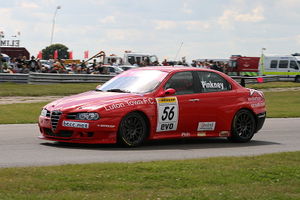

The Alfa Romeo 156 was as well vested in motorsport as its predecessor, the 155. It ran in the British Touring Car Championship as well as various European championships, most notably the WTCC and formerly the ETCC where it was especially successful. The 156 sports car program was run by Fiat Group's partner N.Technology S.p.A., originally founded as Nordauto Squadra Corse to compete in Italian Touring Car Championship. In 1994 name was changed to Nordauto Engineering and 2001 to N.Technology. In 1998 Alfa Romeo also offered for sale the 156 Group N version for the track. The 156 Group N had no carpets, seats or upholstery, but included additional track safety devices.
The 156 has won the following titles:
- 1998 Italian Super Touring Car Championship - Alfa Romeo 156 D2, Fabrizio Giovanardi
- 1999 Italian Super Touring Car Championship - Alfa Romeo 156 D2, Fabrizio Giovanardi
- 2000 European Super Touring Car Cup Winner - Alfa Romeo 156 D2, Fabrizio Giovanardi
- 2001 FIA European Touring Car Championship - Alfa Romeo 156 D2, Fabrizio Giovanardi
- 2002 FIA European Touring Car Championship - Alfa Romeo 156 GTA Super 2000, Fabrizio Giovanardi
- 2003 FIA European Touring Car Championship – Alfa Romeo 156 Super 2000, Gabriele Tarquini
Touring versions:
- Alfa Romeo 156 D2, 1997 cc 310 PS @ 8200 rpm
- Alfa Romeo 156 GTA Super 2000, 1998 cc 260 PS @ 8450 rpm
- Alfa Romeo 156 Super 2000, 1998 cc 275 PS @ 8450 rpm
Coloni S1 Alfa Romeo 156
Italian race car constructor Coloni made an one-off racing car prototype for FIA Group-E Formula Libre called the Coloni S1 Alfa Romeo 156, or 156 Maxiturismo. The car is a carbon fibre silhouette racing car on a tubular frame, powered by a 3.0 litre Alfa Romeo V6 engine producing between 380 bhp and 500 bhp. The car has a 6-speed Hewland-Coloni sequential gearbox and weighs around 900 kg. It is capable of achieving over 310 km/h.
Gallery
| <- Previous | Alfa Romeo Automobiles S.p.A., a subsidiary of the Fiat S.p.A. since 1986, car timeline, 1980s-present | ||||||||||||||||||||||||||||||
| Type | 1980s | 1990s | 2000s | ||||||||||||||||||||||||||||
| 0 | 1 | 2 | 3 | 4 | 5 | 6 | 7 | 8 | 9 | 0 | 1 | 2 | 3 | 4 | 5 | 6 | 7 | 8 | 9 | 0 | 1 | 2 | 3 | 4 | 5 | 6 | 7 | 8 | 9 | ||
| Supermini | Junior | ||||||||||||||||||||||||||||||
| Small family car | Alfasud | 33 | 145/146 | 147 | 149 | ||||||||||||||||||||||||||
| Arna | |||||||||||||||||||||||||||||||
| Compact executive car | Alfetta | 75 | 155 | 156 | 159 | ||||||||||||||||||||||||||
| Nuova Giulietta | |||||||||||||||||||||||||||||||
| Executive car | Alfa 6 | 90 | 164 | 166 | 169 | ||||||||||||||||||||||||||
| Coupé | Sprint | GTV (916) | GT | ||||||||||||||||||||||||||||
| GTV | Brera | ||||||||||||||||||||||||||||||
| Cabriolet | Spider (916) | Spider (939) | |||||||||||||||||||||||||||||
| Sportscar | SZ/RZ | ||||||||||||||||||||||||||||||
| Roadster | Spider | ||||||||||||||||||||||||||||||
| Supercar | 8C Competizione and Spider | ||||||||||||||||||||||||||||||
| Racing car | 179/182/183T/184T/185T | SE 048SP | |||||||||||||||||||||||||||||
